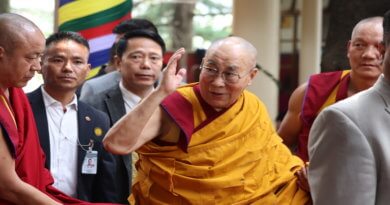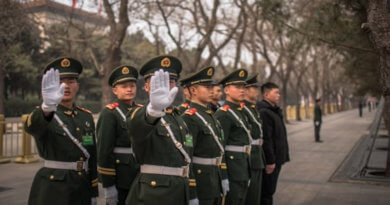An Interview | Pema Tseden on Breaking into the International Scene
Interview conducted & translated by Chime Lama / The Brooklyn Review

Award-winning Tibetan writer and filmmaker, Pema Tseden, makes a stop in NYC along his US tour to discuss his English-language debut, Enticement: Stories of Tibet. Published in 2018 by SUNY Press and translated by Michael Monhart and Patricia Schiaffini-Vedani, this innovative work truly brings modern Tibetan Literature into the conversation.
Chime Lama: Your latest collection of short stories, Enticement: Stories of Tibet, is a literary bridge between Classical Tibetan tales and modern-day stories. The seventh story in this collection is an adaptation of the traditional Tibetan golden corpse tale, but in your version, you introduce the gun. Why do you do this?
Pema Tseden: The golden corpse tale is an oral story of Tibet. Ever since I was young, I’ve had a great love of folktales. That’s why I’ve also translated the Tibetan corpse tale into Chinese. I believe folktales have definitely influenced my own writing. In general, they begin with “A long long time ago…” and continue until the end. However, my folktale “A New Golden Corpse Tale: Gun” opens with “In the future…”. It is our tale that has yet to happen, and was written with an elevated mind. Being that the gun is a modern weapon and contradicts the setting, I deliberately inserted a modern element into the folktale’s subject matter and form.
When you begin to write a new story, do you have any intention to bridge old and new Tibetan customs?
Generally speaking, I think only a few of my Tibetan stories have had such an intention. In Tibetan composition, for instance, the abilities of the Tibetan community are definitely exhibited, and many Tibetan authors have this view. However, personally, it is not the principal aim of my compositions. I believe my tales are ones that are based on the human condition.
To your knowledge, are there many Tibetans today writing creatively through poetry, prose and screenwriting? If there are obstacles to Tibetans doing so, what are the main ones and how could they be remedied?
This topic has many different aspects. There may be many Tibetans who are writing folklore, poetry, prose and the like. Those authors’ compositions will develop out of their individual interests. In terms of script writing, I think it’s acceptable to say that it has slightly increased in Tibet in recent years. Therefore, I believe this field has strengthened a little. I suspect one reason for this minor increase is that they don’t have much intellectual training in film. Another reason would be that they do not have systematic education. So naturally, filmmaking does not become a profession; this would be my answer. Generally, whatever work one pursues, it’s very important to naturally study the core texts of one’s own profession. In terms of movie scripts as well, if there was more clarification on common knowledge, difficulties could be resolved. Often, many young Tibetans will send me scripts. Although many of them may possess some natural form of folktale or oral story, it is difficult for them to become an authentic movie script.
You have made an effort to have your writing translated into many languages. What do you feel is the benefit of this? Do you feel other Tibetan writers share this interest?
If I translate my stories into other languages, many foreign readers will be able to learn about Tibetan lifestyles and literature. Furthermore, I can also expand my readership this way. Therefore, if one were to ask about the benefit of doing this, I would explain it this way: it is principally for my own benefit. Although there are a multitude of Tibetan writers these days, it appears that my written works are clearly being translated more. I believe this is a sign that Tibetan literature is developing.
What do you believe is the benefit of creative writing to Tibetans, and how do you think the practice of creative writing could be increased in Tibetan societies?
In parallel with the increase in Tibetan literary genres, the capacity of Tibetan readers to experience and enjoy literature is advancing. Ten years ago for instance, the trend of Tibetan composition was predominantly to criticize and protest social dilemmas from many different angles. With that, each faction of society developed a consonant power of careful consideration. Presently, however, Tibetan creative writing has reemerged in the form of real literature.
Since your films are based on your stories, how do you initially choose the stories that will become films?
Many readers ask about this. In general, if one wants to adapt a story to a movie script, first one must consider whether it is appropriate for adaptation. Some stories have the foundation to be arranged as a movie script, while others that lack such a foundation should be left as they are. Put briefly, determining whether the story is proper for adaptation is essential. While my stories were not directly adapted to become movie scripts, some pieces were written as scripts from the beginning and later became movies.
Have you ever had to significantly adapt your stories to better suit films? In your experience, what is the difference between a book and a film in terms of their in ability to relay a message and affect the audience?
In my experience, written composition and script writing are two separate disciplines. Since I have continued my practice of creative writing and filmmaking this year, the two have likely influenced each other However, at the outset of writing I do not have any motive to later adapt my stories to film.
Many Tibetans in diaspora face difficulty in mastering Tibetan. In your opinion, if a work is not composed in the Tibetan Language, could it be considered a Tibetan work?
Presently, the spoken and written Tibetan language has become weak. This is the case especially for Tibetans living in cities and their descendants. For them, this situation has become quite serious. That being said, I believe Tibetan writings and movies will continue to have a great effect on preserving the Tibetan language. (Here I am chiefly referring to Tibetan writings and films composed in the Tibetan language).
How can modern Tibetan creative writing help to preserve and develop Tibetan culture?
It is important that modern Tibetan writing contains the component of modern Tibetan culture and knowledge. Tibetan writing has the ability to pass down native traditions and customs, religious beliefs, intellectual perspectives and more from generation to generation. Moreover, modern Tibetan writing has the power to continually stimulate and expand the Tibetan language.
What do you think the future of modern Tibetan creative writing looks like? What could help it grow?
It is a bit difficult to say. If we look at the current situation, it seems as if all aspects regarding the subject matter and stylistic form of Tibetan literature are developing. Therefore, I believe that the field will slightly expand in the future. However, in Tibet, for example, there aren’t many who have the profession of “writer.” Writing is something that has naturally become a secondary activity. Therefore, a rise in those naturally occurring “secondary career” writers and any amount of increase in the exposure of Tibetan writers, such as seeing, hearing and learning about them is good.
( This interview has been edited and condensed. Special thanks to Michael Monhart and Tsemdo la for translation support.)






